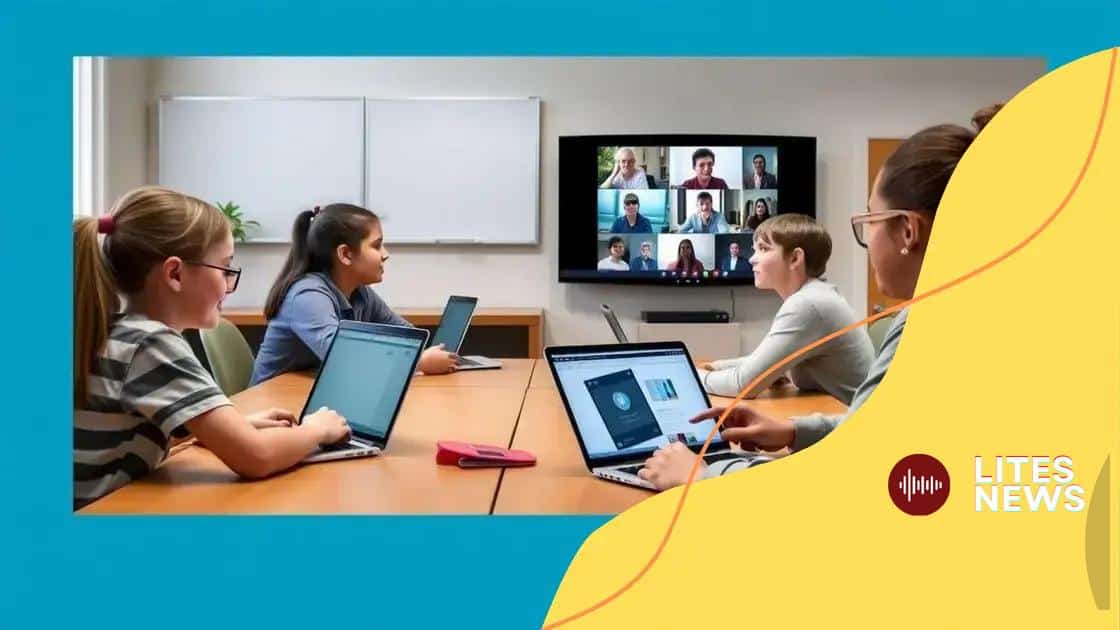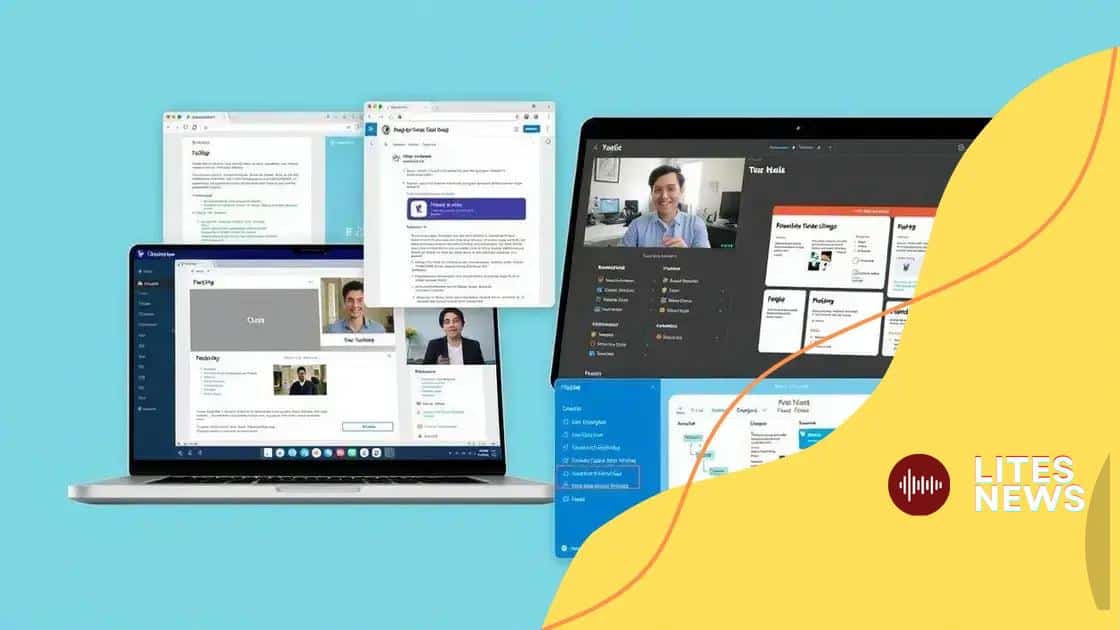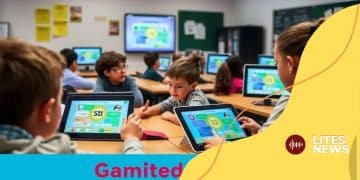The impact of virtual classrooms on student collaboration

The impact of virtual classrooms on student collaboration enhances accessibility, promotes engagement, and fosters teamwork, while also presenting challenges like technical difficulties and the need for effective social interaction.
Have you noticed how the impact of virtual classrooms on student collaboration is changing the way learners engage? This shift invites us to rethink our traditional views on teamwork in education.
Understanding virtual classrooms
Understanding virtual classrooms is essential for grasping how education has transformed in recent years. These digital learning environments provide students with flexibility and accessibility that traditional classrooms may lack.
Virtual classrooms allow educators and students to interact in real-time, regardless of their physical locations. This shift has significant implications for learning. For instance, students can attend classes from anywhere, making education more accessible to those who may face geographical or logistical challenges.
Key Features of Virtual Classrooms
Several features distinguish virtual classrooms from traditional learning settings:
- Real-time interaction through video conferencing.
- Access to a wealth of online resources.
- Flexible scheduling that accommodates diverse student needs.
- Tools that facilitate collaboration among students.
Another important aspect is the use of various technologies that enhance the learning experience. Think about how tools like chat rooms and collaborative documents allow students to work together seamlessly, whether they are near or far from each other. This functionality encourages teamwork, critical thinking, and communication skills, which are key in today’s workforce.
The ability to record lectures is another significant benefit. Students can revisit these recordings, which helps them better understand complex topics at their own pace. Such features cater to different learning styles, ensuring that all students have the opportunity to succeed.
Challenges Faced by Students
Despite the advantages, there are challenges that come with virtual classrooms. Some students may struggle with technology or feel isolated without face-to-face interactions. These experiences can affect their engagement and motivation.
Additionally, maintaining discipline and focus during online classes can be difficult. Students may be distracted by their home environments. Addressing these issues requires support from educators, parents, and the students themselves.
Ultimately, understanding virtual classrooms means recognizing both the benefits and challenges they present. As we continue to adapt to these changes, it becomes clear that innovative ways of learning are here to stay.
Benefits of collaboration in virtual environments
One of the major benefits of collaboration in virtual environments is the increased access to diverse perspectives. When students work together online, they connect with classmates from various backgrounds and locations. This interaction enriches discussions and promotes a deeper understanding of different viewpoints.
Collaboration in these settings helps develop critical skills necessary for the modern workplace. Students learn to communicate effectively while using technology. They also gain experience in problem-solving as they tackle group tasks together. This teamwork experience is invaluable and prepares them for future careers.
Enhanced Engagement
Another notable advantage is enhanced engagement. Virtual collaboration fosters a sense of community among students. When they participate in group projects or discussions, they feel more connected to their peers, even from a distance.
- Students are motivated to contribute their ideas.
- They share resources and tools that benefit the whole group.
- Interaction through chats and forums keeps them involved.
This sense of belonging can lead to improved academic performance. Engaged students are more likely to stay focused and perform better on assignments. They also tend to participate actively in discussions, which deepens their learning.
Flexibility and Convenience
Collaboration in virtual environments also offers unmatched flexibility. Students can participate in group work at times that suit them best. This convenience allows them to balance other commitments, such as jobs or family obligations, while still contributing to their teams.
Moreover, technology provides various tools to facilitate collaboration. Platforms like discussion boards, shared documents, and video calls enable students to work effectively, regardless of their time zones. This versatility is a key factor in successful group work, particularly in a globalized learning environment.
Ultimately, the benefits of collaboration in virtual environments are clear. From enhancing engagement to offering flexibility, these experiences are vital for student success.
Tools that enhance student collaboration

Many tools are available today that significantly enhance student collaboration in virtual classrooms. These resources make it easier for students to work together, share ideas, and complete projects effectively.
One popular tool is online document sharing platforms. These allow students to co-create and edit documents in real-time. Google Docs is a great example. With it, students can see changes as they happen, making collaboration seamless. This feature not only helps with teamwork but also teaches students how to give and receive feedback.
Communication Platforms
Another vital tool is communication platforms such as Zoom or Microsoft Teams. These services enable students to meet virtually, discuss project details, and brainstorm ideas. The ability to have video calls helps maintain a personal connection, similar to meeting in traditional classrooms.
- Video conferencing fosters face-to-face interaction.
- Chat features allow quick and easy communication.
- Screen sharing helps visualize complex ideas.
Using these tools can significantly boost engagement. When students can see and hear one another, they are often more motivated to participate actively in discussions and collaborations.
Project Management Tools
Project management tools also play a crucial role in facilitating collaboration. Platforms like Trello or Asana help students keep track of tasks and deadlines. These tools allow groups to assign responsibilities and monitor progress in an organized way.
Moreover, these platforms promote accountability, as every team member knows what they need to do and by when. This clarity can reduce confusion and ensure that everyone is on the same page.
Overall, the right tools can make a significant difference in how students collaborate online. They facilitate communication, organization, and engagement, allowing students to thrive in a virtual learning environment.
Challenges of virtual classroom interactions
While virtual classrooms offer various advantages, they also present several challenges of virtual classroom interactions. Understanding these obstacles is vital for enhancing the online learning experience.
One significant challenge is the lack of face-to-face communication. In traditional classrooms, students can read body language and facial expressions, which helps convey emotions and intentions. In contrast, online interactions often miss these cues, leading to misunderstandings and reduced engagement. Teachers may find it challenging to gauge student interest and comprehension without the visual feedback typically seen in person.
Technical Difficulties
Moreover, technical difficulties often disrupt learning. Students may face issues like poor internet connectivity or device malfunctions. These technical problems can prevent them from joining classes or participating fully. When students miss out due to technology, they may feel isolated from their peers and the learning process.
- Connectivity issues can lead to missed classes.
- Software glitches can hinder participation.
- Lack of access to devices increases educational inequality.
These challenges can make it hard for students to stay focused and engaged. Additionally, some students may struggle with self-discipline in a less structured environment. Without the physical presence of teachers and classmates, maintaining motivation can be difficult.
Social Interaction Barriers
Social interaction barriers also pose significant challenges. Students often miss out on the social aspects of learning that happen naturally in physical classrooms. Building friendships and networks can be more challenging online, and this lack of socialization can lead to feelings of loneliness or disengagement.
Teachers play a critical role in fostering interaction in virtual environments. They must create opportunities for students to connect, such as breakout rooms and group projects, which can help build a sense of community. Yet, facilitating these interactions can be more complicated in virtual settings.
Ultimately, recognizing the challenges of virtual classroom interactions is the first step in overcoming them. By identifying and addressing these obstacles, educators can improve the online learning experience for all students.
Future trends in virtual education
The future trends in virtual education are shaping the way students learn and interact in online settings. As technology advances, so do the methods of teaching and learning, offering exciting possibilities for both educators and learners.
One significant trend is the increasing use of artificial intelligence (AI) in education. AI can personalize learning experiences for students by analyzing their strengths and weaknesses. This tailored approach helps maintain engagement and ensures that each student learns at their own pace. For example, AI can provide targeted resources that suit a student’s learning style, promoting better understanding and retention of material.
Blended Learning Models
Another trend gaining traction is the adoption of blended learning models. This approach combines online education with traditional in-person instruction. By integrating both methods, students can benefit from the flexibility of online learning while still receiving face-to-face interaction with teachers and peers. This model encourages engagement and fosters community.
- Students can learn through various formats, such as videos, discussions, and hands-on activities.
- Teachers can assess student understanding more effectively by observing them in both settings.
- This model allows for greater adaptability in lesson planning, catering to different learning styles.
Furthermore, as virtual reality (VR) and augmented reality (AR) technologies improve, they are beginning to play a vital role in education. These technologies create immersive learning experiences that transport students to different environments. Imagine exploring ancient ruins or conducting science experiments in a virtual lab. This hands-on approach makes learning more engaging and memorable.
Focus on Social-Emotional Learning
As we look to the future, there will also be a greater emphasis on social-emotional learning (SEL) in virtual education. Educators are recognizing the importance of addressing students’ emotional well-being alongside their academic growth. Integrating SEL into virtual classrooms fosters a supportive environment where students feel valued and connected. Teachers will use collaborative projects and discussions to cultivate empathy and communication skills.
Overall, the future trends in virtual education show great promise. By embracing these changes, educators can create dynamic and effective learning environments that meet the needs of all students.
FAQ – Frequently Asked Questions about Virtual Classrooms
What are the main benefits of virtual classrooms?
Virtual classrooms increase accessibility to education, promote collaboration, and allow for personalized learning experiences.
How can technology enhance student collaboration in virtual settings?
Tools like online document sharing, communication platforms, and project management tools facilitate teamwork and improve engagement.
What challenges do students face in virtual classrooms?
Students often struggle with technical difficulties, lack of social interaction, and maintaining motivation without face-to-face support.
What future trends can we expect in virtual education?
Expect increased use of AI for personalized learning, blended learning models, and a greater emphasis on social-emotional learning.





